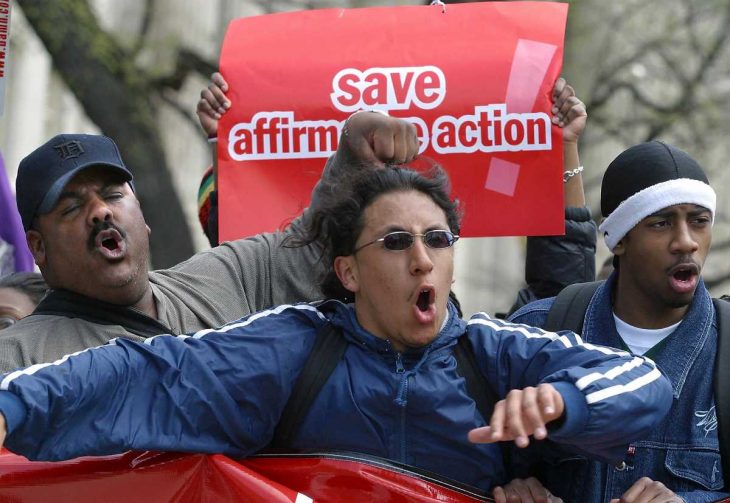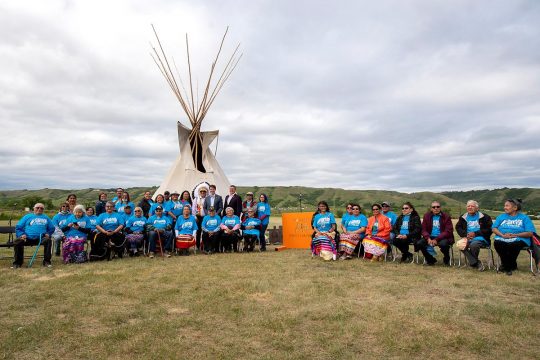The recent wave of anti-racist protests has resurfaced demands for civilian accountability boards to address police violence, reparations for decades and centuries of racist oppression, and truth and reconciliation processes to acknowledge historical and ongoing injustices. Such demands are calling not only for racial justice, but for “transitional justice,” a set of measures implemented to address massive human rights abuses. However, racial justice advocates also demand other measures that are crucial to racial transition, yet currently unrecognized by the field of transitional justice—including affirmative action.
My research shows how affirmative action is central to the United States’ transition from white supremacy. Affirmative action emerged during the 1960s as an attempt to undo the legacies of racial subordination. In a 1965 speech that paved the way for affirmative action, President Lyndon B. Johnson recognized that “you do not take a person who, for years, has been hobbled by chains and liberate him, bring him up to the starting line of a race, and then say, ‘You are free to compete with all the others,’ and still justly believe that you have been completely fair.”
Affirmative action against racial inequality
Despite several decades of legal challenges, affirmative action has survived as a transitional practice. Since the 1970s, the U.S. Supreme Court has struck down government programs that take race into account, even if it is to help Black and other racialized people. Despite this approach, the Court’s affirmative action decisions have allowed the indirect use of race, recognizing its role in achieving a society free of race-based discrimination.
In 2003, Grutter v. Bollinger allowed affirmative action to continue because the Supreme Court believed that a transition from the nation’s past was incomplete. Justice O’Connor pointed to “the unique experience of being a racial minority in a society, like our own, in which race unfortunately still matters.” As she explained: “By virtue of our Nation’s struggle with racial inequality, [minority] students are both likely to have experiences of particular importance to the Law School’s mission, and less likely to be admitted in meaningful numbers on criteria that ignore those experiences.”
In last year’s ruling in Students for Fair Admissions v. Harvard, District Judge Allison D. Burroughs concluded that retaining affirmative action is necessary for moving the United States toward a society in which affirmative action is no longer needed. “The rich diversity at Harvard and other colleges and universities and the benefits that flow from that diversity will foster the tolerance, acceptance and understanding,” Burroughs wrote, “that will ultimately make race conscious admissions obsolete.”
A central measure for more than 50 years
Because affirmative action is one of the few race-sensitive policies to have survived legal scrutiny, it occupies a central place in American transitional discourse. Understandings of the racial past out of which the nation is emerging, the racial future it ought to pursue, and the transition pathway between them are forged in debates over affirmative action. Therefore, those looking to implement traditional transitional justice measures in the United States must first understand the country’s leading transitional measure over the past half-century—affirmative action.
While affirmative action cannot—and was never meant to—accomplish all the work that a transition to racial equality requires, it remains crucial. A 1966 report of the White House Conference on Civil Rights endorsed affirmative action as “essential and urgent to generate more and better jobs for Negroes, assure access to existing jobs by Negro men and women, and to eliminate discrimination in employment and occupational advancement.” However, far from being a discrete remedy, affirmative action was one of nine proposed reforms relating to the promotion of “economic security and welfare” for Black people, in addition to reforms relating to education, housing, and the administration of justice, which were covered separately. Dr. Martin Luther King, Jr., whose words are sometimes invoked to challenge race-based affirmative action, supported both racial quotas and a war on poverty. Understanding affirmative action as part of a larger transition project thus aligns with aims of the Civil Rights Movement and reflects current needs.
As transitional justice practitioners and researchers turn their attention to the United States, they should recognize that affirmative action specifically addresses inequalities in order to surmount the past, even if it is not yet widely recognized as a transitional justice measure. The transitional functions of affirmative action include integrating historically segregated spaces, increasing political power for marginalized groups, breaking down racial stereotypes, and promoting cross-racial understanding and harmony. Even if affirmative action by itself is not enough to alleviate socioeconomic inequalities, it somewhat uniquely brings attention to this dimension of transition.
A mean to dismantle systems of oppression
At the same time, transitional justice actors are well-placed to point out the risk of overreliance on (and overburdening of) affirmative action as a means to achieve racial equality. Affirmative action is sometimes expected to solve racial injustice when it is only one part, albeit a vital part, of the racial transition project. Affirmative action’s limitations should be overcome by understanding it in relation to, and employing it in tandem with, other transitional justice measures.
Today’s racial justice movements demand reparations for past and continuing harms to black people; investment in healthcare, housing, and education for Black people; economic justice for Black people; and a political system in which Black people can exercise their political power, among other changes. These demands highlight how overlapping systems of oppression hold back Black people in the United States—systems that cannot be dismantled without affirmative action, or through affirmative action alone.
There is a larger lesson here for researchers and practitioners of transitional justice. In focusing on a limited set of measures such as truth commissions and criminal prosecutions, transitional justice actors have sometimes given the impression that these measures constitute the complete range of responses available to transitional societies. It is time to add affirmative action to the transitional justice “toolkit” and to pay closer attention to the other means through which societal transitions occur.
 OXFORD TRANSITIONAL JUSTICE RESEARCH
OXFORD TRANSITIONAL JUSTICE RESEARCH
This article has been published as part of a partnership between JusticeInfo.net and the Oxford Transitional Justice Research (OTJR), a network of high-level transitional justice researchers which is part of the University of Oxford. Justiceinfo.net publishes OTJR publications under the joint responsibility of its editor and OTJR.
 YUVRAJ JOSHI
YUVRAJ JOSHI
Yuvraj Joshi is a doctoral candidate at the Yale Law School and a fellow of the Yale Institution for Social and Policy Studies.






